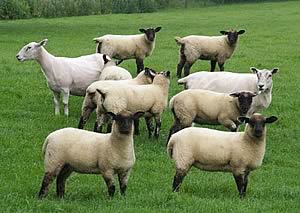|
31/03/07
Improved growth rates in lambs fed concentrates containing a
commercial yeast cell wall supplement contributed to increased
net profits of over £1.30/head in farm trials conducted
in 2006 by Countrywide Farmers.
Cannon Heath lambs
 |
The policy of Cannon Heath Farm, a Hampshire downland
farm where the 2006 study was conducted, is based on the view that
on their land, well managed grazing supplemented with lamb creep
feed is the most cost effective way of finishing lambs. Any additional
ways of improving the efficiency of lamb output from grass and
obtaining a positive financial response is considered.
An increase in profitability of £1.30 per head is certainly
worthwhile under any circumstances and this return could well be
higher in situations where there is a greater disease challenge.
In the study involving 400 lambs all bred from mule ewes by either
Texel or Dorset rams and born between 15 and 31 March, the treatment
group receiving Alltech’s Bio-Mos mannan oligosaccharide
yeast cell wall extract in a standard creep ration fed ad libitum
from 14 days to slaughter at 14 weeks of age, recorded higher daily
liveweight gains than the control group.
The biggest impact was seen in the period up to 10 weeks of age,
when daily liveweight gain was 4-5% higher in lambs receiving Bio-Mos.
The shepherd, Andrew Stephens was impressed that the Bio-Mos fed
lambs took to the creep earlier and also showed a reduced incidence
of scours. There was no mortality in lambs receiving Bio-Mos compared
with two cases in the control group.
In earlier trials carcase quality of slaughtered lambs was also
assessed and a significant improvement in killing out percentage
was seen in lambs that received Bio-Mos.
“Bio-Mos is widely used in other livestock species for its
ability to improve gut health and growth rates but up until now
there has been little evidence of its efficacy in relation to lambs,” explains
Countrywide Farmers feed technical manager Jim Fordyce.
“Further trials are in progress but the results over two
years to date have been very positive, with improvements in the
health of the animals leading to significantly better growth rates.”
|
CONTROL |
BIO-MOS |
BIO-MOS GAIN |
DLWG to 10 weeks (kg) |
0.341 |
0.357 |
+4.7% |
DLWG to slaughter (kg) |
0.344 |
0.351 |
+2.0% |
Mortality (lambs lost) |
2 |
0 |
|
Disease incidence |
12 |
5 |
|
Source: Countrywide Farmers, 2006
 New Multi-Source Magnesium Improves Efficacy of Cattle Grazing Minerals New Multi-Source Magnesium Improves Efficacy of Cattle Grazing Minerals
 The Magic Circle - Soil, Forage, Livestock The Magic Circle - Soil, Forage, Livestock
 Improved Lamb Milks From Trouw Nutrition Improved Lamb Milks From Trouw Nutrition
|



